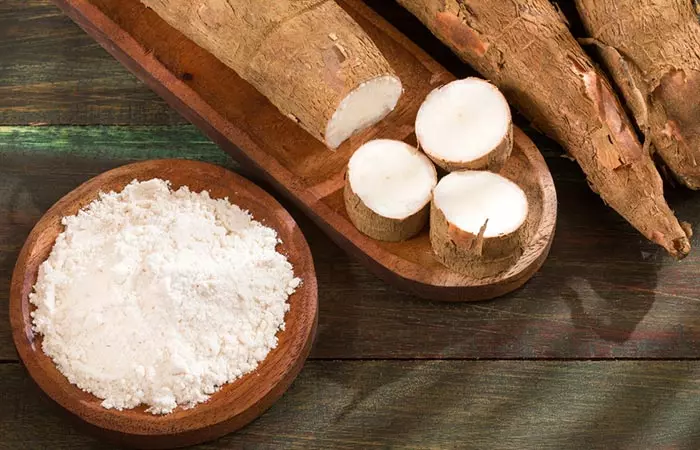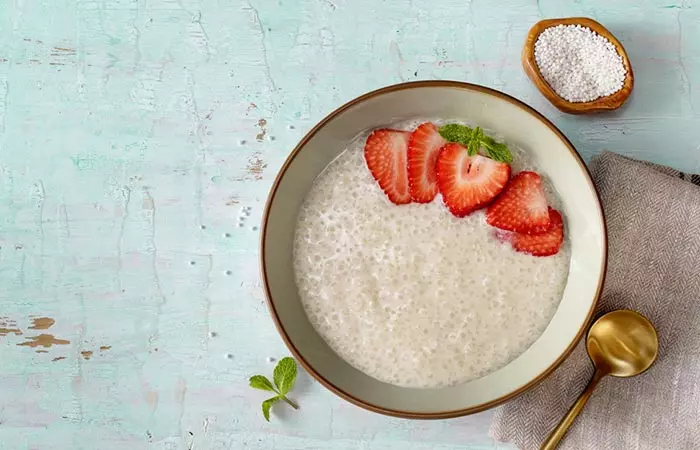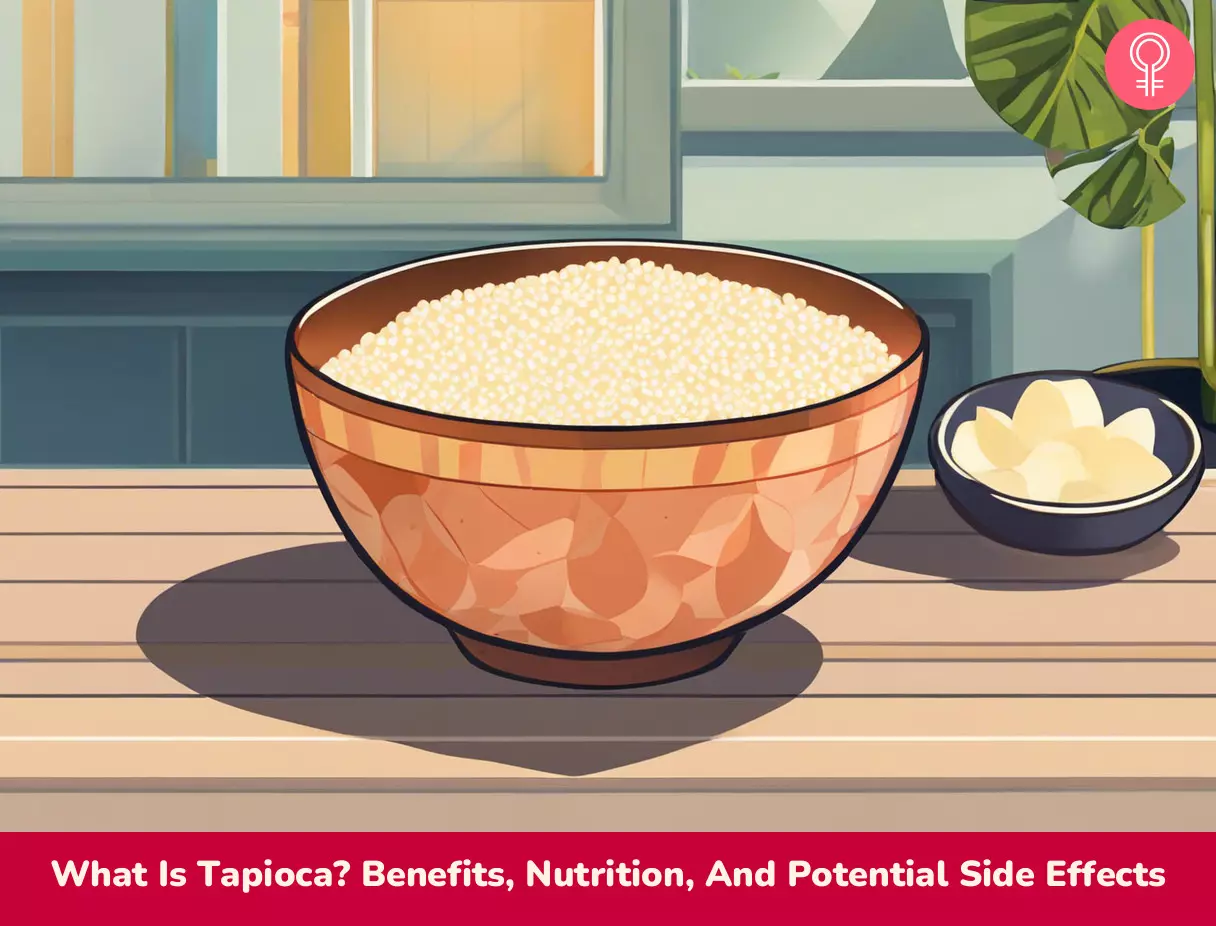In this article, we explore the health benefits of tapioca, its nutrition, possible side effects, and a few simple recipes to try. Who Can Use It? It is considered safe for most people for those with pre-diabetes and diabetes. How Often? You can consume it daily in moderation. Caution Consuming improperly processed cassava products can be dangerous as they may contain cyanogenic glycosides and may also cause konzo, anaphylaxis. Tapioca is used as a thickening agent in soups and sauces as it has a neutral flavor and strong gelling power. There are many tapioca varieties available on the market, including chips, noodles, and wraps. These are used in traditional as well as innovative cuisine. Pearls are the most common form of tapioca, which are opaque when raw but become translucent when cooked in boiling water. You can find tapioca in the gluten-free section of supermarkets and food stores. So, what nutrients does tapioca provide? Keep scrolling to know more about its vitamin and mineral content.
Tapioca Nutrition Facts
According to the U.S. Department of Agriculture, one cup (152g) of dry, pearl tapioca contains (1): So is tapioca healthy? Yes, this nutrient-rich profile of tapioca is sure to benefit your health in many ways. We explore its four major benefits in the following section. Keep reading.
Health Benefits Of Tapioca
The starch obtained from the root of cassava benefits your body in many ways. Here are the top advantages you should know about.
1. May Improve Digestion
Trista Best, RDN, says, “Tapioca is quite easy to digest and easy on the gut since it is not inflammatory in nature. This allows it to help mitigate and prevent gastrointestinal issues common to other flours and thickeners.” Besides, the fiber in tapioca may help improve digestive health. A review published in the World Journal of Gastroenterology suggests that dietary fiber intake may increase stool frequency in people with constipation (2). Moreover, high fiber intake may also reduce the risk of distal colon cancer (3). Additionally, since digestive health is associated with skin conditions like eczema and acne, adding tapioca to your diet may improve your skin health. However, more research is needed to support this claim.
2. May Support Weight Gain
Lisa Richards, a nutritionist, says, “There are times when weight gain is necessary for an individual whether it be for personal fitness goals or to improve health. Tapioca makes an excellent aid to a diet focused on weight gain”. “A cup of tapioca pearls is over 500 calories and approximately 135 grams of carbohydrates. One of the most beneficial aspects of using tapioca for weight gain is the fact that it will not cause an increase in cholesterol like other means of weight gain tend to do,” she adds.
3. May Promote Heart Health
Tapioca contains no saturated fat. Long-term trials found that reduced saturated fatty acid intake may decrease the risk of combined cardiovascular diseases by 21 percent (4). Another study found that the antioxidant flavonoids and alkaloids in cassava help manage cardiovascular complications, including heart disease. Furthermore, fiber is anti-dyslipidemic – it helps reduce the risk of abnormally high cholesterol levels in the blood. This also contributes to a reduced cardiovascular disease risk (5). However, more studies are needed to understand this phenomenon of tapioca in humans and how it helps the heart and immune system.
4. Is Suitable For People On Restricted Diets
According to research, one in every 141 persons has celiac diseasei An immune reaction to gluten in which its consumption can inflame and damage the intestine’s lining. in the United States (0.711%) (6). Tapioca is grain-, gluten-, and wheat-free and is the best option for people with gluten sensitivity. Therefore, it is the best substitute for wheat flour in baking. Tapioca flour is also often used by those on a paleo diet or an autoimmune protocol dieti A diet based on the paleolithic era that encourages people to eat unprocessed foods in order to lose weight and prevent heart diseases. . In addition, lactating mothers consume cassava leaf products to boost their breast milk production (7).
5. May Support Healthy Pregnancy
Tapioca is a great source of iron with one cup containing approximately 2.4 mg of the nutrient (8). The recommended daily intake of iron ranges from 8 to 18 mg for adults, depending on their gender and age. However, the intake value significantly increases to 27 mg for pregnant individuals (9). This extra intake is required to provide substantial support during fetoplacental development and increase protection against symptoms of anemia. Hence, it may be beneficial to consume tapioca for pregnancy. As with many other healthy foods, tapioca too may have some side effects. Scroll down to know.
Side Effects Of Tapioca
There are no documented reports on the side effects of tapioca. However, consuming improperly processed cassava products can be dangerous as they may contain cyanogenic glycosides (that can cause cyanide poisoning) (10). Moreover, several deaths were reported in Nigeria after consuming improperly processed cassava (11). A study by Faro Central Hospital (Portugal) found that it may also cause a neurological disease called konzo that affects regular brain function (12). Cassava may also cause anaphylaxis (serious allergic reaction) in people with latex allergies due to cross-reactivity (13). Tapioca starch does have a high glycemic indexi A scale that measures rates of carbohydrates in food from 1 to 100, depending on how much they influence the blood glucose level. that can cause a spike in insulin and blood sugar and may therefore be unsuitable for those with pre-diabetes and diabetes.
What Is Tapioca Used For?
Tapioca flour makes gluten-free and grain-free bread, and is often used to make casabe (a type of flatbread). Tapioca can also be eaten as breakfast, dinner, or dessert with different toppings. Tapioca pearls are used to make puddings, snacks, or bubble tea. Tapioca can be used as a thickener for soups, sauces, and gravies. It has a neutral flavor and does not alter the taste of the original dish. You can also add it to burgers, nuggets, and dough to improve their texture and moisture.
You can also prepare some delicious recipes with tapioca. In the following section, we list three simple tapioca recipes to try at home.
Tapioca Recipes
1. Tapioca Pudding
What You Need
Small pearl tapioca – ½ cup Large eggs – 2 Whole milk – 3 cups Sugar – ½ cup Salt – ¼ teaspoon Vanilla extract – 1 teaspoon
Process (Note: It will take anywhere from 5 minutes to 45 minutes of cooking based on the type or brand of tapioca you are using)
2. Bubble Tea
What You Need
Black tea – 8 bags (loose-leaf black tea – 3 tablespoons) Quick-cooking tapioca pearls – ¾ cup Hot water – 4 cups Whole milk – to serve Simple syrup – to serve
For The Simple Syrup
Water – ½ cup Sugar – ½ cup
Process
3. Blueberry Tapioca Pie
What You Need
Sugar – 7 tablespoons Tapioca granules – 2 tablespoons Fresh blueberry – 4 cups All-purpose flour – 1 tablespoon Lemon juice – 1 tablespoon Pre-made pie crusts – 2 Milk – 1 tablespoon Vanilla ice cream – for serving
Process How do you store tapioca effectively to avoid spoilage and extend its shelf life? Scroll down to know.
How To Store Tapioca?
Tapioca pearls can last for about 6 to 12 months if left unopened. Tapioca flour stays good for years if sealed tightly. Keep it in a cool, dry area but not in the refrigerator or freezer. If you soak and sweeten tapioca pearls to make boba, consume within four hours. Discover the hidden treasure of tapioca and unlock its health benefits in the video below! Dive into a world of natural energy, gut-friendly goodness, and gluten-free delight. Can tapioca help you lose weight? No. Tapioca does not aid weight loss. Instead, it may help in healthy weight gain due to its high carb content without adding any unhealthy cholesterol. Is tapioca good for your stomach? Yes. Tapioca is good for your stomach. It can be included in the low-FODMAP dieti FODMAP lists food items that can cause intestinal stress. Eating a low-FODMAP diet can help manage gastrointestinal disorders. , and its intake can improve the symptoms of Irritable bowel syndrome (IBSi A gastrointestinal condition that affects the stomach, causing diarrhea, abdominal pain, constipation, and flatulence. ) (14). Is tapioca good for high blood pressure? Even though there is no direct link between tapioca consumption and blood pressure, it is low in sodium and can be a good choice of a staple for people with hypertension. Is tapioca good for kidney disease? Processed plant-based foods high in starch, such as tapioca, can be included to simplify the diet for people with chronic kidney disease. However, the portion and frequency of consumption should also be kept in mind when taking tapioca for kidney problems (15). Is tapioca good for ulcers? Tapioca is a low-acid food that is less likely to irritate the internal lining of the stomach. Due to this, it can be a safe food to eat when suffering from ulcers. There have been studies conducted on whether tapioca is effective in healing ulcers and are still open for research.
Illustration: What Is Tapioca? Benefits Nutrition And Potential Side Effects












